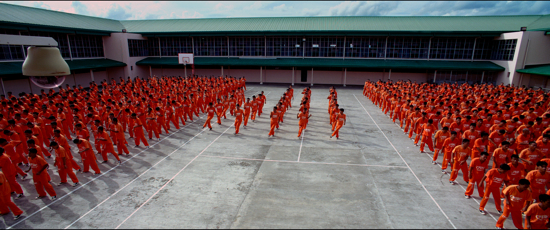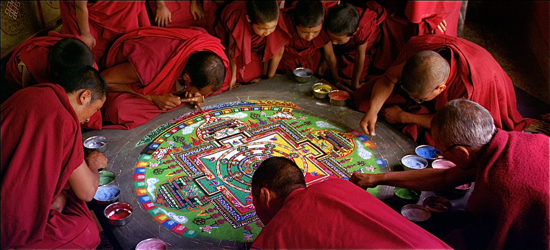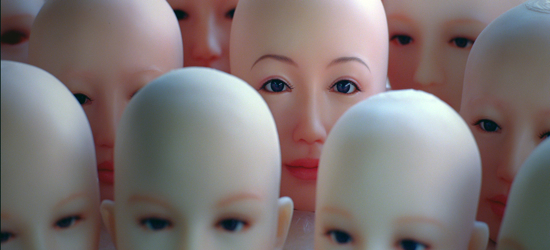A slaughterhouse. Prayers at Mecca. A sand mandala painstakingly created and then destroyed. An erupting volcano. Homes devastated by Hurricane Katrina. Young monks. Gun-toting families. A sulphur mine. A Los Angeles freeway. The day’s progression over a gothic cathedral.
Such are the images of Samsara, the third part in a trilogy begun with Chronos (1985) and Baraka (1992). Named for the Sanskrit word loosely defined as the cycle of birth, death and rebirth, this feature was assembled over five years and 25 countries by director Ron Fricke and producer Mark Magidson. (Fricke cut his teeth as cinematographer on the similarly non-narrative Koyaanisqatsi, three decades ago.) There is no text or dialogue throughout the 99-minute running time. But viewers come away with the sense of an emotional story despite the lack of obvious plot. This is largely due to the filmmakers’ commitment to making the movie with the theme of impermanence present in all the imagery that they chose.
Samsara is also unique from a technical standpoint because it was shot on 70mm film, whereas most contemporary motion pictures utilise 35mm (or, increasingly, digital). In addition to the rich detail offered by their choice of format, Fricke and Magidson use time-lapse photography to stirring ends throughout. Yet another thing which sets the movie apart is its haunting score, created by Lisa Gerrard (of Dead Can Dance), Michael Stearns and Marcello De Francisci. This soundtrack was the last thing added to the picture, which Fricke and Magidson edited as a silent.
Fans of Baraka will certainly be enchanted by Samsara, but the new film is not merely a sequel. Baraka (a Swahili word for "blessing") focused mainly on natural imagery. Certain scenes (the image of people in Japanese napping pods comes to mind) reminded viewers of the current era, but for the most part there was a timeless, environmental quality to Baraka, whose concept, according to Fricke, was <a href= "http://purecinema-celluloid.webs.com/ronfricke.htm" target=”out”">"humanity’s relation to the eternal". Meanwhile, Samsara, based on the eternal’s opposite – impermanence – is full of images of violence, technology and manufacturing, including a sex doll factory. These images are, of course, juxtaposed with more, well, timeless visuals of impermanence, such as the creation of the sand mandala, the Chinese Dance of a Thousand Hands, and the natural transience found in a volcano’s eruption. While Samsara‘s theme may be impermanence, Fricke and Magidson have created a film with a lingering presence.
When you were making Samsara, did you piece the sequences together in your head, or did that all happen during editing?
MM: We didn’t really worry too much about putting it together editorially ahead of time. We went out and gathered imagery that was related to the broad concept of ‘samsara’ – birth, death and rebirth – imagery associated with impermanence. The real key to the structure of the film was that sand mandala sequence. Once we filmed that on the dock in India, we really felt like we had the film and went out and filmed other material that supported the concept. You really have to put it together in the editing process in a film like this.
To a certain extent, the story is left very open for the viewer to interpret, but you also have your authorial intent. How did you walk that line as you were making the movie?
MM: Just from experience and being careful not to overly comment on any one point of view. It’s trying to walk a careful line between editorialising and doing so without a strong point of view of if something is good or bad, letting the essence of the imagery speak for itself. Part of that is also the choice of music, a spacious kind of sound.
I read that you edited it without any sound to keep it starker.
MM: We edited in silence, and that’s really letting the image determine the flow of the film, and then we brought the score in later.

Was there footage you had that you didn’t or couldn’t use?
MM: No, we used basically everything that we had that was good. It’s all in there.
You shot on 70mm film. What does that mean for the DVD release, when the film is meant to be seen on a big screen?
MM: We shot on 70mm, but we also outputted it to a digital theatrical output that’s super-high quality. The DVD or Blu-Ray is going to be phenomenal because it embodies all the qualities of the 70mm film within it. That’s what we did with the Blu-Ray for Baraka. We scanned it in at 8K, a super-high scan rate. It really embeds the quality of the 65mm negative into the digital file.
What was the most difficult scene for you to get?
MM: The toughest single shoot was this shoot we had in a sulphur mine in Eastern Java, in Indonesia. We were engulfed by sulphuric acid vapour. When they’re mining the sulphur, there’s this vapor that’s coming out of this volcanic lake. It’s literally sulphuric acid. It’s floating around and there’s clouds of it, and when you’re in the wrong place and the wind changes, you’re just engulfed in this caustic [acid]. You’re inundated with [it]. Your eyes are burning, your throat’s burning – very tough shooting conditions. You have to get out of there as quick as you can.
What were some of your favorite places to shoot?
MM: We had a wonderful shoot in Burma over the temples in a hot air balloon where we just hit it really lucky. That was perfect. That’s the opening sequence in the film. Our shoot in Ladakh was great, where we filmed the sand painting, just because it was so meaningful to the film, and to come away with it was very satisfying. Had we not, we would have had a lot of issues structuring the film. We have these moments that are, like, you feel like you’ve got that and you’re in great shape moving forward to finish it.

Were there any accidents in the movie? Things you just happened to catch?
MM: Oh, yes. We call them “happy accidents”. There’s things that you find. You go out with a list of subject matter, location by location that you’ve researched, but there’s also things that happen that you find that you didn’t know about. There’s a fair amount of that. One example of that is Ron and I were in a book shop in Ethiopia, in Addis Ababa and found this book on these tribes of the Omo Valley, which is a region in the southern part of Ethiopia and the northern border with Kenya, and we just made a last-minute decision. This book had amazing imagery of these different tribes, and we just said, “Let’s try to get down there.” We just put it together in a couple of days and got down there and filmed that. It’s a really big part of the content of the film.
What do you think the score adds to the movie?
MM: That’s the emotional commentary, the music. It accompanies the imagery and brings a level of depth of feeling to the experience. Half the experience is the visual and half the experience is the music.
Did you give the musicians any direction, or just show them the movie and let them come up with whatever they wanted to do?
MM: The way the process worked was that we had the film and we had edited it in sequences, and we broke the sequences up as pieces of music that we wanted them to compose. So it was Lisa and Marcello doing some of it, and then Michael Stearns doing other pieces, and they were all in Los Angeles for a long time, like six months. They would do sketches, and Ron and I would comment. Then they’d zero in and finish the music that way. It was very interactive. We were just hanging out together working on the music all the time. The edit was done, so we just focused on the music for that time frame.
Samsara Official Teaser Trailer (Ron Fricke, 2011) from Arrow Films on Vimeo.
What other components are important to you that aren’t as noticeable as the film stock or the music?
MM: I think the overarching component is how the film is structured. You try to structure it seamlessly where you’re drawn through the experience and where sequences connect and flow together, scene to scene. That’s the goal of how the film is structured, to keep you in that flow, in a feeling state.
Feelings of impermanence, or just being open to all kinds of feelings?
MM: Feelings of connection, as human beings watching this, just watching life experience and how that unfolds all around the world everywhere that we went.
Was it difficult to do that and put your ego and politics to one side?
MM: It’s just a discipline of how you structure the film and let it flow together. It’s just our approach to it. It’s an evolution from the other films.
How do you see it as an evolution from Baraka?
MM: It’s got more disturbing images in it than Baraka did. It’s a little more urban in feeling. It’s a little more contemporary, you could say. [But] it has that in common, that it’s about a feeling state: an inner journey that hopefully the viewer feels a strong connection to, the phenomenon of life around the world now.
Samsara opens in UK cinemas on Friday August 31.


